Ultimate Guide to Product R&D with Prioritization Frameworks
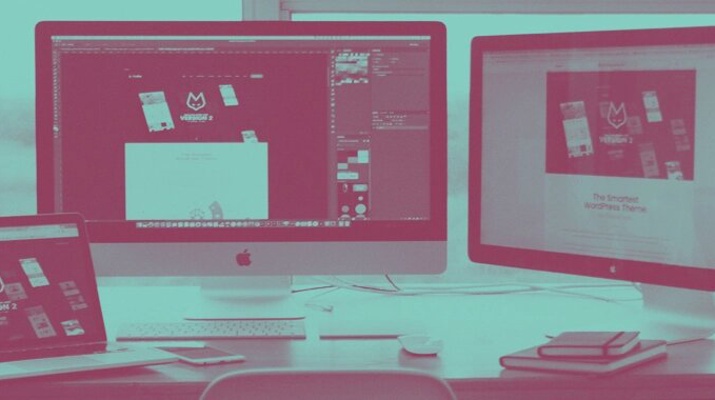
Ultimate Guide to Product R&D with Prioritization Frameworks
This guide walks you through the process of market research so you can achieve product-market fit easily. This, coupled with the right prioritization process speeds up your go-to-market journey while helping your team continue to collect data that will impact product decisions down the line.
Every product starts with a single idea. But throughout its life, that idea will go through a snowball effect and quickly become an unmanageable bedlam of ideas thrown by everyone who has even a minor stake in the project.
“People think focus means saying yes to the thing you’ve got to focus on. But that’s not what it means at all. It means saying no to the hundred other ideas that there are. You have to pick carefully.” – Steve Jobs
While those ideas may seem valuable, resources are always limited and a major part of a product manager’s job is to prioritize what needs to be built and whatnot.
How do you choose and what to prioritize? Here’s a complete guide about using a prioritization framework to easily pick what you need to focus on.
A Pitfall of Listening to Customers
The first step in product development is to understand the needs of your customers. Every idea needs to be validated by the customer. And the best way to do that is by talking directly with them.
“Get Out Of The Building” or Outside-in Product Development are the terms used for customer-led product development.
However, while these are best practices for developing products, there is one caveat attached to this approach.
When you start asking customers what features they’d like, you’ll eventually end up with a lot of data. This makes you prone to the fatal mistake of taking every suggestion and feedback given by the customer and adding it to the product’s feature set.
Plus, if the product is in the MVP development stage, avoiding this mistake can mean the difference between success and failure for your business.
While the customer is always right, you need a process to manage all the ideas and data you collect so that you can get to market in a reasonable time with a product that your customers will actually want.
Why do you Need a Prioritization Framework?
Not having a process means you’re often acting impulsively and making crucial product decisions without any data to back them up.
A solid prioritization framework and process gives you data to easily get buy-in from stakeholders as well as the confidence that you’re headed in the right direction.
With a healthy process in place, it also becomes easy to rank and bucket feature ideas as you start receiving feedback and input once you take your product to market.
Building your Product Roadmap with Prioritization Frameworks
Prioritization frameworks are helpful when you have done your homework and figured out the basics. First, you have to determine answers to the following questions:
- Who you are selling to?
- What needs do those people have and what problems are you solving?
- What is the unique value proposition of your product?
- What are your strategic business goals?
Once you’ve got this down, you can pick any prioritization framework to build your product roadmap.
Additional Resources for Product Design and Development Support by Location:
Identify your Target Customers
If the product hasn’t been launched yet, you’ll only have a hypothesis of who your customer will be. Try to be as accurate with your hypothesis as possible.
Interview the people you’ve identified as your customer and find out if they really need a product you’re developing. Keep in mind that it’s possible that you’ll attract a totally different breed of users once you launch your product to market.
Think of your product as the fishing bait. The fish you catch with that bait is your customer. The only way to actually know for sure which fish you’ll catch is by lowering the bait in the water.
This is another reason why you need to speed up the development of your MVP so you can start refining the product for the target customer segment it’s actually attracting.
Interview Customers About Their Needs
Same as above, you’ll start the process by coming up with a hypothesis of what you think your customer would find valuable.
The goal here is to create a list of hypothetical customer benefits and then test them out by talking to the customer.
Have discovery interviews with them one-on-one. Send surveys that list out your customer benefits and ask them to rate each benefit or feature based on how much value they perceive in it.
Here's what the survey should look like:

After you've prepared and garnered the background information you need, it's time to start using prioritization frameworks to complete the product R&D process.
5 Product R&D Prioritization Frameworks
Here are the frameworks and their associated purposes that we'll examine in this guide:
- Importance versus Satisfaction framework: identify needs
- KANO Prioritization framework: find your focus
- KANO Model: value proposition creation
- Impact–Effort Prioritization framework: MVP development
- Olsen’s Hierarchy of Web User Needs: future prioritization
These frameworks will quicken the go-to-market journey while making sure you make sound decisions throughout.
1. Importance Versus Satisfaction Framework: Identify Customers’ Underserved Needs
The next step is analyzing the gap between how important a certain feature is for the customer and how satisfied they already are with the existing solutions that deliver that feature.
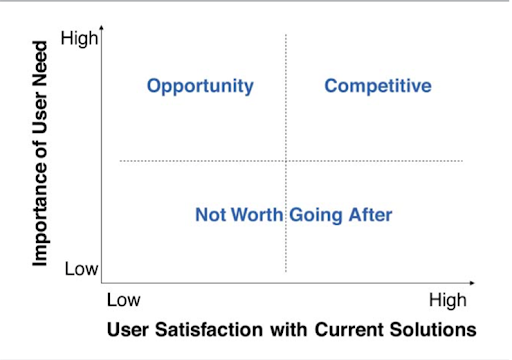
Plot your main product benefits on an Importance vs Satisfaction framework. Your goal here is to identify features that rank high in importance but low in satisfaction. This is your opportunity area.
This technique is what Google used when they launched their search engine in the market.
Google wasn’t the first search engine when it launched. But here’s the reason why it was an instant success.
Google first listed three main benefits that customers were looking for in a search engine. Those were:
- Number of search results
- Freshness
- Relevance
Using the Importance vs Satisfaction prioritization framework, Google found out that Relevance had a high importance rating but low satisfaction rating. Meaning customers found high value in relevance but weren’t satisfied with how relevant existing search engines were at that time.
Google found its area of opportunity and quickly launched a product that took the industry by storm.
This gap analysis will inform you what your main focus should be when developing products.
2. KANO Prioritization Framework: Find Your Focus
The KANO model plots two parameters on horizontal and vertical axes: how fully a customer need is met on the horizontal axis and its resulting impact on customer satisfaction on the vertical axis.

This framework lets you identify the product features that will have the most impact on customer satisfaction. It also lets you identify features that you must have to avoid customer dissatisfaction.
Use the data you collect from customer interviews to plot your feature ideas on this framework. The KANO model lets you categorize your ideas in three buckets:
- Must-Haves: Must-haves are the first ones to prioritize. If these must-have needs are not fully met, the customer is going to be dissatisfied with your product. However, meeting those must-have needs doesn’t result in customer satisfaction. And so, adding performance benefits and some delighters are necessary for competing in the market.
- Performance Benefits: The more performance benefits the better. The result of meeting performance benefits is linear to customer satisfaction. Not meeting any performance needs leads to dissatisfaction while adding some performance benefits equally leads to satisfaction. These features should be the next ones to prioritize after must-haves.
- Delighters: These features are your differentiator. While these don’t cause dissatisfaction if not met, they are a wow factor for customers and will help you stand out.
3. KANO Model: Create a Value Proposition for Your Product
The next step in building out your product roadmap is to nail your value proposition.
Once you’ve bucketed your feature ideas into must-haves, performance benefits, and delighters, it’s now time to identify the performance benefits and delighters that you’ll use to compete and create your value prop.
As a word of caution, you can’t focus on all the performance benefits and delighters you can think of. That’s a strategy doomed to failure.
Go back to your gap analysis and find out how customers are ranking each performance benefit and whether they’re satisfied with that particular benefit offered by other products.
You’ll also need to evaluate your competitors and see which performance benefits they’re focusing on.
If you focus on those same benefits, you’ll have a hard time competing with them. A better strategy is to find your area of opportunity by identifying the underserved customer needs which other competitors are not fulfilling.
Once you’ve identified the performance benefit you’ll focus on, all future versions of your product will focus on improving the quality of that particular feature set. Once you’ve perfected that performance feature set of your product, you can then develop other features to expand your performance benefits.
The same goes for delighters. If your competitors are focusing on Delighter 1, you should come up with your own version of a delighter, Delighter 2, and keep your focus on that. However, make sure the idea is validated by talking to customers and taking their input.
Here’s a template for creating your Product Value Proposition. Go through each row and evaluate your competitors and your own product.
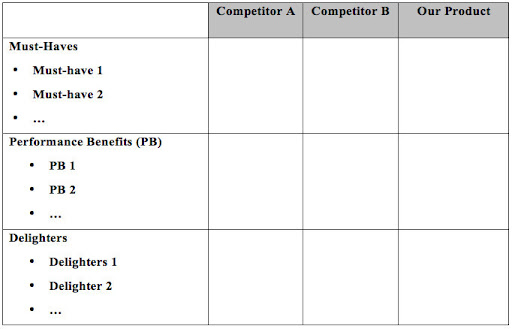
Get all the must-haves as these are bare essentials customers are expecting and score the performance benefits and delighters that your product will focus on as described above.
A clear value proposition decreases your chances of launching a me-too product and allows you to focus your resources on what’s most important.
4. Impact–Effort Prioritization Framework: MVP Development
With MVP (minimum viable product) development, the goal is to get to market as fast as possible so you can start collecting data and make future product decisions based on that.
Knowing what benefits you’re going to focus on, your goal with MVP development is to identify the top three to five features that will provide that said benefit.
To get more specific with your prioritization, use the impact-effort framework to prioritize based on a feature’s ROI or its position in the impact vs effort matrix.
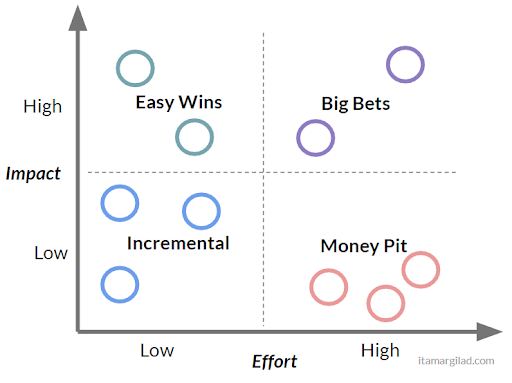
In this three-by-three grid, you plot all feature ideas in one of these nine squares based on development time and the resulting impact on customer value.
You’ll want to focus and prioritize the features that have high impact but require low effort and go ahead from there.
5. Olsen’s Hierarchy of Web User Needs: Future Prioritization
Here’s one last prioritization framework we’re going to talk about. This one should inform all your future decisions as you start rolling out new versions of the product.
This hierarchy is a good reference whenever you’re planning a new version of your product.
Should you focus on that exciting feature idea or dedicate resources to improving the uptime of your site?
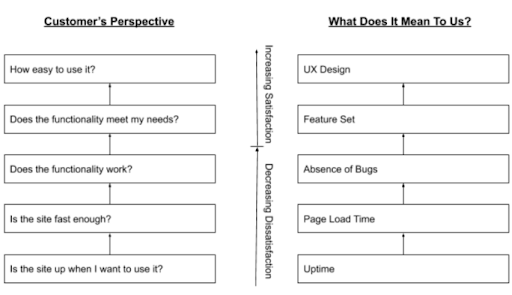
This hierarchy lists customers’ needs with the most critical ones at the bottom. You need to meet the bottom three needs to avoid customer dissatisfaction and then move on to meeting the top 2 needs.
This framework will form a guideline for all future product roadmaps. For example, if you find out after launching version 2 of your product that its performance has slipped, the next version of your product should focus on improving performance first before improving the UX of the site.
Prioritization Frameworks Facilitate the Product R&D Process
Product R&D isn't simple, but prioritization frameworks can make things run a bit more smoothly.
By making proper use of the Importance versus Satisfaction framework, the KANO prioritization framework, the KANO model, the Impact–Effort prioritization framework, and Olsen’s Hierarchy of Web User Needs, you are taking active steps to guide your team toward success.
Got a product idea? Contact Codup to discuss and get it developed by our dev teams.
